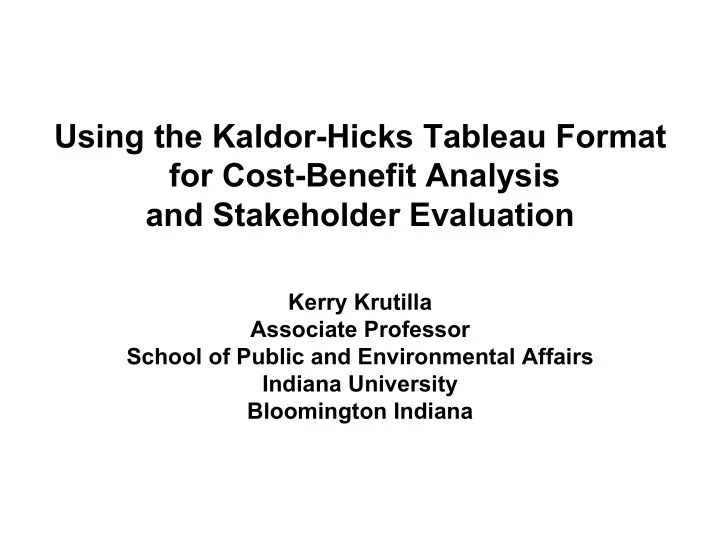

Using the Kaldor-Hicks Tableau Format for Cost-Benefit Analysis and Stakeholder Evaluation Kerry Krutilla Associate Professor School of Public and Environmental Affairs Indiana University Bloomington Indiana
Kaldor-Hicks Tableau (KHT) • A matrix display of a project’s economic and financial effects on stakeholders at an aggregation level the analyst chooses. • Gives a fully-integrated and internally consistent picture of all project’s effects at chosen aggregation level • Advantages of KHT Format – For Efficiency Analysis 1) transparent evaluation/stakeholder education 2) stakeholder impact analysis to assess political feasibility 3) stakeholder impact analysis to assess project sustainability 4) iterative simulation modeling of project design alternatives – For Beyond-Efficiency Analysis 5) distributional effects assessment/multiple goals analysis
Current Role of KHTs in Project Appraisal I. International Development The World Bank, Handbook on Economic Analysis of Investment Operations, 1996, World Bank, Washington, D.C Jenkins, G. Project analysis and the World Bank, The American Economic Review 87: 38-42, 1997. II. “ Stakeholder Analysis” in Social Policy Long, D. and C.D. Maller, C.V.D. Thornton, Evaluating the benefits and costs of the jobs corps, Journal of Policy Analysis and Management 1: 55-76, 1981.
Justification for Greater Application 1 of 2 Begs questions: do stakeholder effects subsumed in “traditional” CBA matter? ”involuntary” impacts raise questions about political acceptability Shepsle and Weingast, Political solutions to market problems, American Political Science Review 78: 418-434, 1984. ”voluntary” impacts raise questions about project sustainability Jenkins, G. Evaluation of stakeholder impacts in cost-benefit analysis, Impact Assessment and Project Appraisal 17: 87-96, 1999. Harrison, G., I. Morten, and M. Williams. Estimating individual discount rates in Denmark: A field experiment, The American Economic Review 92: 1606-1617, 2002. Warner, J. and S. Pleeter. The personal discount rate: Evidence from military downsizing programs, The American Economic Review 91: 33-53, 2001.
Justification for Greater Application 2 of 2 • Particular issue: Jurisdictional Stakeholders and Accounting Domains • KHT format offers a conceptually consistent, integrated analysis of economic efficiency and all stakeholder effects. • Informational Issues? Qualitatively Different than Others? • Aggregation/Sensitivity Analysis can be used to address informational issues
Using the KHT Format for Broader Assessments than Economic Efficiency Analysis • Normative Assessment of Distributional Effects Boardman, A., D. Greenbert, A. Vining, and D. Weimer. Cost-Benefit Analysis: Concepts and Practice, 3rd Edition. ( Upper Saddler River , N.J: Pearson, Prentice Hall, 2006 ) Harberger, Basic needs versus distributional weights in social cost-benefit analysis, Economic Development and Cultural Change 32: 455-474, 1984. • Warm Glow and Moral Sentiments Hanemann, W. Valuing the environment through contingent valuation, The Journal of Economic Perspectives 8: 19-43, 1994. Portney, P. The contingent valuation debate: Why economists should care, The Journal of Economic Perspectives 8: 3-17, 1994. Zerbe, R. Should moral sentiments be incorporated into benefit-cost analysis? An example of long-term discounting, Policy Sciences 37: 305- 318, 2004. • Other Analysis Permutations Beyond Efficiency Vining, A. and A. Boardman, Metachoice in policy analysis, Journal of Comparative Policy Analysis 8: 77-87, 2006.
Conclusions • More standard usage of the KHT format could improve efficiency analysis within CBA • Having a KHT as the target output should force the degree of stakeholder analysis needed to assure the projects benefits and costs are accurately depicted, as well as offering a completely-integrated accounting of a project’s economic and financial effects. • Particular Strengths – Format transparency – evaluation of jurisdictional impacts and different accounting stances – iterative project design analysis for political acceptability and project sustainability – adaptability to other kinds of analyses besides standard economic efficiency
Recommend
More recommend